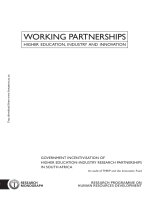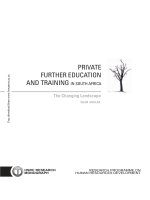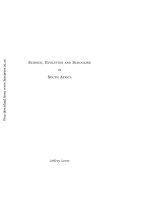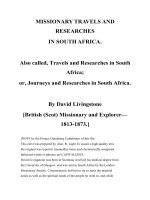Industrialisation and race in South Africa, 1886–1994
Bạn đang xem bản rút gọn của tài liệu. Xem và tải ngay bản đầy đủ của tài liệu tại đây (3.98 MB, 15 trang )
P1: RNK
0521864381c12 CUNY780B-African 978 0 521 68297 8 May 15, 2007 16:38
12
Industrialisation and race in South Africa, 1886–1994
modern south africa deserves separate treatment, because the
discovery of gold at the Witwatersrand in 1886 gave the south a trajectory dif-
ferent from the rest of the continent, moving towards an industrial economy,
the entrenchment of local white power, and a unique system of racial repres-
sion culminating in the apartheid programme of 1948,acentrally imposed
programme of racial segregation under white domination. Yet although South
Africa was as distinct from the rest of thecontinentasPharaonic Egypt, it shared
manyunderlying historical processes. The most fundamental was demographic
growth, from perhaps three million or four million in 1886 to thirty-nine mil-
lion in 1991.Aselsewhere, this bred competition for rural resources, mass
urbanisation, generational conflict, and the overextension of the state. In the
early 1990s, these conditions, together with industrial development and the
international context, enabled black people to force their rulers to seek secu-
rity in a long-term settlement. Majority rule in 1994 left South Africa facing the
socio-economic problems troubling the whole continent, but its peak popula-
tion growth rate was past and it possessed skills and resources making those
problems potentially easier to surmount.
mining and industrialisation
The Witwatersrand goldfield in 1886 differed greatly from the early diamond
diggings at Kimberley. There were no black claim-owners, for the Witwaters-
rand was not in the officially multiracial Cape Colony but in the South African
Republic (Transvaal), whoseAfrikanergovernment immediatelyconfinedmin-
ing claims to white men. Nor did small white miners long survive, for in the
unique geology of the Witwatersrand tiny flecks of gold were scattered in a
narrow seam of hard rock – one ounce of gold in every four tons of rock –
demanding deep mining, heavy machinery, and the most modern chemical
extraction technology. By the late 1890s, shafts were eleven hundred metres
deep and the Rand was producing over a quarter of the world’s gold. From
the beginning, therefore, the Witwatersrand was dominated by giant mining
houses, drawing some capital from Kimberley but most fromEurope. Industrial
nations bought gold at fixed prices but in practically unlimited quantities. The
273
P1: RNK
0521864381c12 CUNY780B-African 978 0 521 68297 8 May 15, 2007 16:38
274 africans: the history of a continent
mining houses therefore had no incentive to restrict production or compete
with one another. As early as 1889, they formed a Chamber of Mines, chiefly
to reduce African wages, for with prices fixed and labour taking more than
half of production costs, mining profitability depended on controlling wage
levels. White miners, initially needed for their skills, brought from Kimber-
ley the practice of reserving skilled work for white men, which accorded with
the existing racial system of the South African Republic. Their militancy won
them ten times the average black wage in 1898,twicethe ratio at Kimberley
adecade earlier. To accommodate this differential without destroying profits,
the Chamber of Mines combined in 1896 to force African wages down to a level
that remained substantially unchanged until 1971.
This wage reduction was made possible by changes in the supply of African
labourers. Most were migrants, not because mineowners wished it – they
thought migrant workers expensive and inefficient – but because Africans
refused to exchange rural land rights for a lifetime amid the danger, disease,
and brutal conditions of deep-level mining – ‘hell mechanized’, as a mission-
ary described it. Initially, therefore, mineowners had to pay wages sufficient
to attract Africans temporarily from their homes, but this changed as Africans
lost their independence. In 1895–7, especially, the Portuguese conquered the
Gaza kingdom in southern Mozambique and imposed taxation and compul-
sory labour, which were quickly followed by cattle plague and famine. By 1896–8
the goldmines drew three-fifths of their fifty-four thousand African workers
from southern Mozambique, which supplied the largest single contingent of
mineworkers almost continuously until the 1970s. Many others came from the
Transkei and from Lesotho, 20 percent of whose able-bodied men were work-
ing in South Africa at any moment in 1911 and 47 percent in 1936.Instead of
working abroad once in early youth, men came to spend their lives oscillating
between homes and workplaces. Rural economies came to depend on their
remittances. Rural families adapted to survive absent fathers, often replacing
the patriarchal and polygynous homestead by a three-generation household
in which a wife lived with her parents and children until her husband retired,
perhaps bringing home tuberculosis, which by 1930 infected a large majority
of the Transkei’s adults.
ForAfrican cultivators, gold mining initially expanded the profitable urban
market already opened at Kimberley. Maize production increased among Zulu,
Sotho, and especially the peoples of the Orange Free State, the South African
Republic, and Natal, where African peasant farmers with ox-ploughs expe-
rienced a prosperity that their children remembered as a golden age, either
farming the minority of land remaining to them or cultivating as sharecrop-
pers on white farms. From the 1890s, however, white entrepreneurs competing
for urban markets and African labour sought to transform sharecroppers first
into labour-tenants and then into landless labourers. The Natives Land Act
P1: RNK
0521864381c12 CUNY780B-African 978 0 521 68297 8 May 15, 2007 16:38
Industrialisation and race in South Africa 275
14.Industrialisation and race in South Africa.
of 1913 had this objective, for it prohibited land transfers between races, fixed
the African share of South African land at 7 (later 14)percent, and restricted
the number of sharecroppers and cash-tenants who could reside on a white
farm outside the Cape Province. But legislation alone could not change the
countryside. Between the wars there was violent agrarian conflict as farmers
imposed more severe terms on resident Africans, who replied by burning crops,
slaughtering stock, and hearkening to the millennial promises of religious and
political prophets. As late as 1954,some20 percent of ‘white’ farms had no
white resident, but by then the mechanisation of agriculture was finally driving
sharecroppers and tenants from the land, as elsewhere in Africa. Meanwhile
the growing population on the limited and overexploited African reserves was
impoverished. Even in the 1920s, the reserves produced only half their food
needs and the proportion fell steadily thereafter. Only tiny privileged elites
clung to the freehold property needed to finance education and professional
careers.
The commercialisation of agriculture in response to mining and urban
growth also transformed the rural white population. Their farms became
P1: RNK
0521864381c12 CUNY780B-African 978 0 521 68297 8 May 15, 2007 16:38
276 africans: the history of a continent
smaller and more numerous, but the bijwoners (squatters) who had grazed
their scrawny beasts on the fringes of nineteenth-century estates were driven
from the land to join the more than 300,000 white people (about one-sixth
of the entire white population) thought in 1930 to be ‘living in great poverty’,
often in the slums of industrial cities. Given South Africa’s hard and ancient
rocks, poor soils, and recurrent droughts, it cost the state
£
112 million in sub-
sidies to European agriculture between 1911 and 1936 to keep white men on
the land and to win their votes, chiefly through a state-supported marketing
system, elaborate extension services, and transport geared to farmers’ interests.
Unlike white settlers elsewhere, most South African farmers did not become
producers of specialised export crops like wine or coffee. Despite low yields,
maize was 39 percent of their output by value in 1919 and 32 percent in 1976.
This white monopoly of the food market deprived Africans of bargaining
power to push their wages above bare subsistence. The number of African
and Coloured farm labourers rose gradually to a peak of about 1,500,000 dur-
ing the 1960s. Most were poorer than either African townsmen or the reserve
population, earning an average wage from all sources of
£
20 ayear in the late
1930s.
Although goldmining was vital to South African industrialisation, it did
not automatically cause it, for eighty years of copper mining did not industri-
alise the Congo, nor was South African industrialisation a sudden process. In
1891 the Cape Colony’s manufacturing output was already more valuable than
its diamond production. In the South African Republic, however, goldmin-
ing stimulated railway building, urbanisation, coal mining, and the coal-fired
electricity that became the chief source of industrial power. By 1914 the Witwa-
tersrand possessed the world’s largest electrical power station, employing the
latest German technology. Manufacturing output expanded during the First
World War and almost doubled during the 1920s. One reason for industrial
growth, in contrast to tropical Africa, was that political independence allowed
white South Africans to be economic nationalists. General Smuts, as Prime
Minister from 1919 to 1924,made industrialisation a target of state policy. The
Afrikaner Nationalist government that replaced him in 1924 raised protective
tariffs and invested mining revenue in industry, notably the state-owned Iron
and Steel Corporation, which began production in 1934 and spearheaded the
transition to heavy industry that countries further north later found so difficult.
From 1933,when South Africa abandoned the gold standard, greatly increased
gold prices stimulated even faster growth and enabled the economy to escape
the foreign-debt trap that was to check industrialisation in Algeria and else-
where during the 1980s. Between 1911 and 1945 the proportion of South Africa’s
foreign debt to total public debt fell from 91 to 3 percent.
1
Another crucial
breakthrough took place during the Second World War, when manufacturing
employment rose by 60 percent and the engineering industry shifted from craft
P1: RNK
0521864381c12 CUNY780B-African 978 0 521 68297 8 May 15, 2007 16:38
Industrialisation and race in South Africa 277
production to mass manufacture, initially of war materials and subsequently
of consumer durables. The share of metal products and machinery in man-
ufacturing output rose between 1936 and 1951 from 4 to 19 percent, making
South Africa decisively a manufacturing country, with many characteristic fea-
tures of a late-industrialising economy: large enterprises, a major state sector,
heavy reliance on primary exports (of gold), and severe repression of labour.
Cheap labour, cheap energy, gold, government, and gradualism were distinctive
features of South African industrialisation.
Its most dramatic consequence was rapid urbanisation. In 1891 Cape Town,
with 51,000 inhabitants, was South Africa’s largest city, but by 1896 Johannes-
burg, only ten years old, already contained 100,000 people, half white and half
black, in an urban anarchy described as ‘a Monte Carlo superimposed upon a
Sodom and Gomorrah’.
2
The country’s total urban population, some 1,225,000
in 1904,rose to 3,218,000 in 1936, including 68 percent ofallwhite people and
19 percent of Africans. Municipal authorities tried to control urbanisation by
segregating Africans into locations, which became national policy under the
Natives (Urban Areas) Act of 1923.Toimpose this model on a swollen mining
town like Johannesburg, however, was beyond municipal capacity. When the
city centre’s notorious multiracial slums were demolished during the 1930s, for
example, their African inhabitants moved not to the distant, expensive, and
strictly controlled locations at Orlando (the nucleus of modern Soweto) but to
freehold land at Sophiatown and Alexandra on the edges of the white city. In
Cape Town, similarly, some 37 percent of the residential area was still racially
mixed in 1936, notably the largely Coloured working-class area called District
Six, close to the city centre.
Until the 1920s, the main threat to mineowners and the state came not from
Africans but from European workers. Initially most white miners were immi-
grant bachelors seeking quick earnings before tuberculosis killed them. They
vigorously defended their jobs and racial wage differentials against employers
anxious to replace them by equally competent but cheaper Africans. The white
miners’ tactics were militant unionism and racialism. In 1893 the first all-white
mineworkers’ union imposed a monopoly of blasting against the employers’
resistance. Twenty years later a strike obliged the employers and the state to
recognise the union. From 1911 to 1925,the Labour Party largely controlled
the Johannesburg City Council, whose employees briefly established a soviet
in the City Hall during 1918.ACommunist Party came into being in 1921.A
year later, when the mineowners tried to break the union and reduce the ratio
of white workers, ‘Strike Commandos’ converted a strike into the Rand Revolt,
which briefly seized power in several mining towns until suppressed by the
army at a cost of between 150 and 220 lives. At this point, however, the state
used its victory to domesticate both capital and labour. The Mines and Works
Amendment Act of 1926 fixed the ratio of white to black workers, enabling
P1: RNK
0521864381c12 CUNY780B-African 978 0 521 68297 8 May 15, 2007 16:38
278 africans: the history of a continent
mineowners to mechanise the industry and miners to become the best-paid of
white workers.
Forblack workers, by contrast, early militancy brought little reward. Spo-
radic African dock strikes in Port Elizabeth and Cape Town can be traced
back to the mid-nineteenth century, but the first major African mine strike on
the Witwatersrand in 1913 was broken by troops with fixed bayonets. Rapid
industrialisation, urban growth, and inflation during the First World War then
radicalised white-collar workers as well as manual labourers, breeding sev-
eral unsuccessful strikes in 1917–20 and the first major African trade union,
the Industrial and Commercial Workers Union (ICU). This emerged in the
Cape Town docks during 1918, was led by a migrant clerk from Nyasaland
named Clements Kadalie, and expanded first into an urban general union and
then into near-millennial rural protest expressing the grievances of threatened
sharecroppers and labour-tenants on the highveld. At its peak in 1927, the ICU
claimed 100,000 members, but it then disintegrated in factionalism and disillu-
sionment. By 1933 there were only threeAfrican trade unions in South Africa, all
unrecognised by the state. During the next decade, Communist and Trotskyite
organisers gradually constructed a more substantial labour movement fromthe
shop-floor upwards. Wartime militancy culminated in 1946 in a major African
mine strike, but its violent suppression, with at least nine deaths and twelve
hundred injuries, demonstrated the continuing dominance of employers and
the state.
politics 1886–1948
Mining and industrialisation transformed South African politics. In 1899 the
British launched the costlyAnglo-Boer War to protecttheir regional supremacy
against the South African Republic’s new wealth and power, but Afrikaner guer-
rillas surrendered only when the Peace of Vereeniging of May 1902 promised
that ‘the question of granting the Franchise to Natives will not be decided until
after the introduction of self-government’.
3
British control of South Africa
depended on attracting enough English-speaking immigrants to the Transvaal
to outvote its Afrikaners. That meant restoring and expanding gold produc-
tion, which depended on recruiting sufficient nonwhite labour. Because not
enough Africans accepted work at the wages offered, some sixty thousand Chi-
nese contract labourers were imported. But this alienated English-speaking
white workers, who dashed imperial plans in 1907 by allying politically with
Afrikaner leaders.
These events were crucial to Afrikaner nationalism. Nineteenth-century
Afrikaners had been strongly aware of their difference from Britons and
Africans, but during the last thirty years of the century responsible government
at the Cape and the growth of moremodern states in the northern republics had









